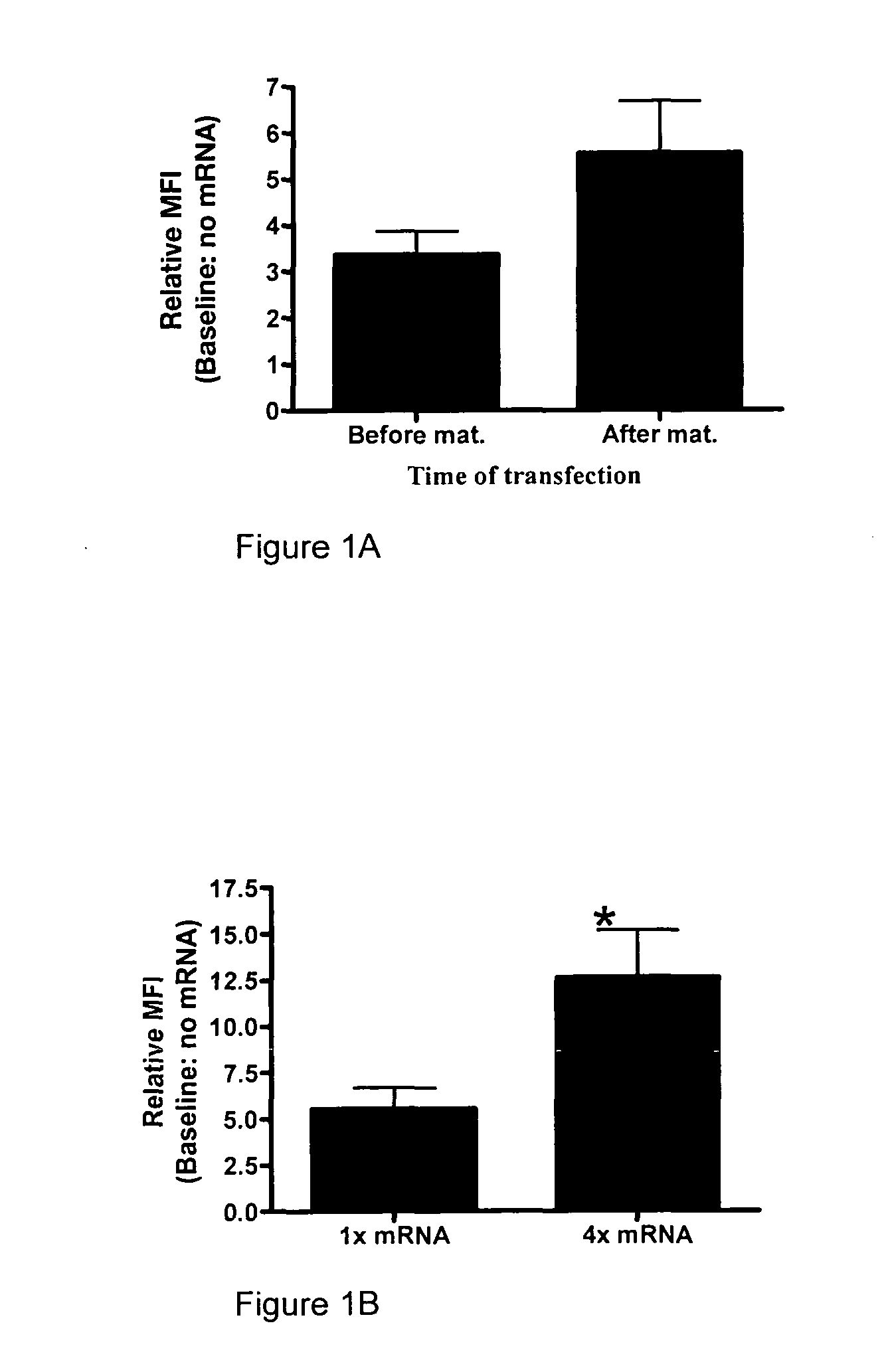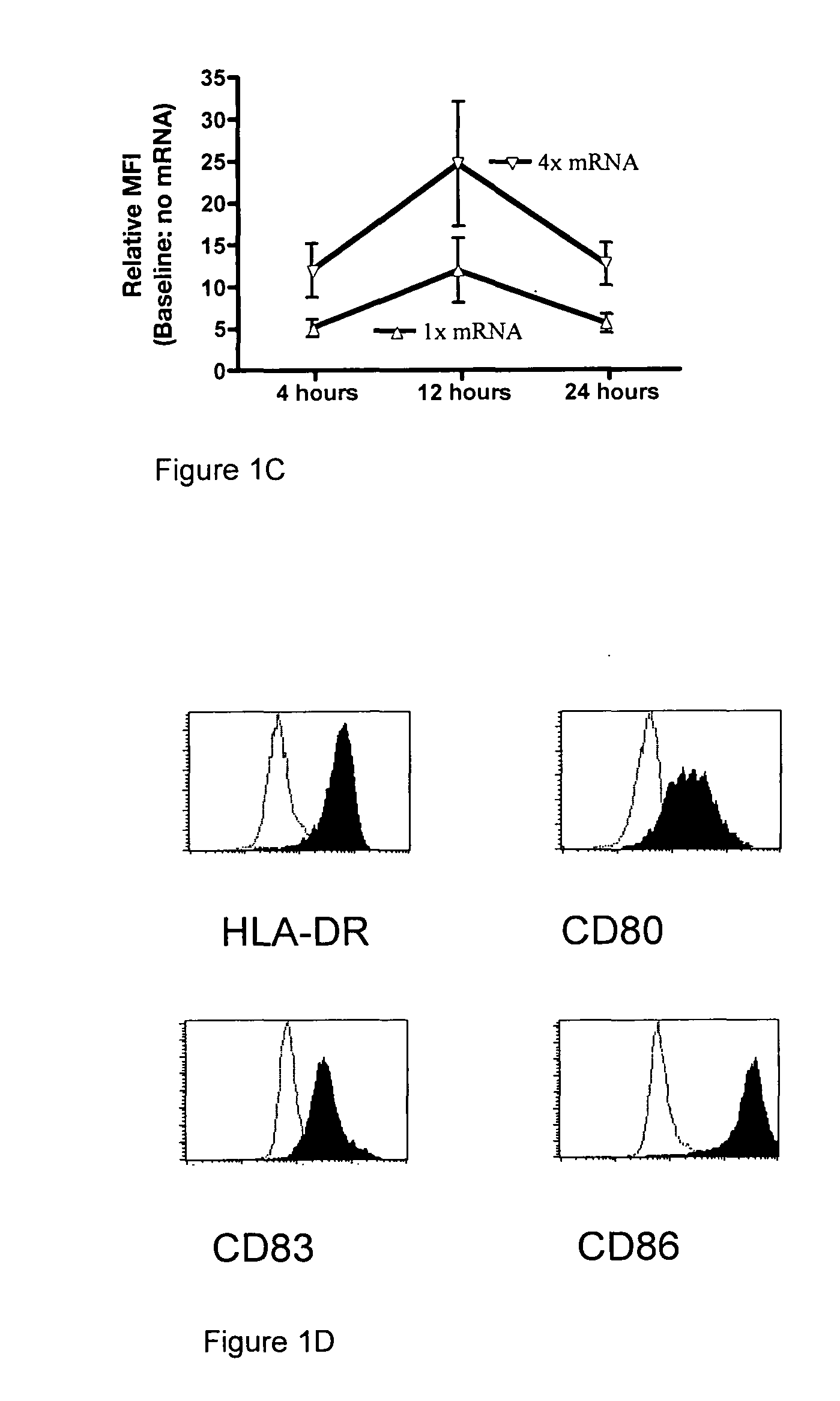Polypeptides
a polypeptide and polynucleotide technology, applied in the field of polypeptides and polynucleotides, can solve the problems of cll cell killing ability of t cells generated in these studies, impede wide-spread use, and ineffective monotherapy with anti-cd20 (cd20 being a b-lymphoid restricted antigen),
- Summary
- Abstract
- Description
- Claims
- Application Information
AI Technical Summary
Problems solved by technology
Method used
Image
Examples
example 1
Optimizing mRNA-Transfection of MoDC: Effects of Transfecting Cells Before or After Maturation, and of Increasing Concentrations of mRNA
[0217]Monocyte-derived dendritic cells (moDC) were transfected before or after maturation, and were analyzed 24 hours after transfection. Maturing the moDC before transfection led to an increased level of expression of HLA-A*0201 at 24 hours following the transfection. Relative mean fluorescence intensity (MFI) was calculated by dividing the MFI of the cells electroporated with mRNA by the value of cells electroporated without mRNA. (n=4). The results are shown in FIG. 1A.
[0218]MoDC were transfected after maturation with increasing concentrations of mRNA. Increasing the concentration of mRNA 4 times led to significantly higher expression of HLA-A*0201 (*=p<0.05). (n=4). The results are shown in FIG. 1B.
[0219]Following maturation, moDC were transfected with HLA-A*0201 mRNA at two different concentrations, and analyzed at t=4, 12 and 24 hours post tr...
example 2
Optimizing mRNA-Transfection of MoDC: Effect of Increased Pulse Length
[0221]MoDC were transfected with HLA-A*0201 mRNA after maturation for 24 hours, and the expression of HLA-A*0201 and cell viability was assessed at 24 and 48 hours post transfection.
[0222]Viability was measured by labeling the cells with propidium iodide prior to flow cytometric analysis. A fixed number of beads were added to each sample, allowing accurate calculation of the number of cells in the sample. Percentages of viable cells were calculated by dividing the absolute number of viable cells in the samples transfected for 1, 2 or 3 ms, respectively, by the absolute number of viable cells in the samples that had not received an electric impulse. Increasing the pulse length did not significantly affect the viability of the moDC. (n=4). The results are shown in FIG. 2A.
[0223]The expression of HLA-A*0201 was analyzed by flow cytometry and the results are shown in FIG. 2B. Relative MFI was calculated by comparing ...
example 3
Induction of MART-1 Positive CTL from HLA-A2 Negative Donors
[0224]Monocyte-derived dendritic cells (moDC) from HLA-A*0201-negative donors were transfected with HLA-A*0201 mRNA after maturation. 18-24 hours post-transfection the cells were pulsed with the peptide ELAGIGILTV from the melanoma-associated antigen MART-1 for four hours, before co-culturing them with autologous responder cells (monocyte-depleted PBMC). At d12 of co-culture, the cells were harvested, stained with relevant or control peptide-MHC-pentamer. The percentage of pentamer positive cells was calculated by dividing the number of pentamer positive cells by the number of CD8+ cells. FIG. 3A shows representative data from 2 of 11 donors.
[0225]The cells were sorted by flow cytometry (not shown) or by magnetic bead separation with anti-PE microbeads after labeling the pentamer positive cells with PE-conjugated MART-1 pentamers using MACS system from Miltenyi. By running the cells over two subsequent columns, the cells we...
PUM
| Property | Measurement | Unit |
|---|---|---|
| concentrations | aaaaa | aaaaa |
| concentrations | aaaaa | aaaaa |
| concentrations | aaaaa | aaaaa |
Abstract
Description
Claims
Application Information
 Login to View More
Login to View More - R&D
- Intellectual Property
- Life Sciences
- Materials
- Tech Scout
- Unparalleled Data Quality
- Higher Quality Content
- 60% Fewer Hallucinations
Browse by: Latest US Patents, China's latest patents, Technical Efficacy Thesaurus, Application Domain, Technology Topic, Popular Technical Reports.
© 2025 PatSnap. All rights reserved.Legal|Privacy policy|Modern Slavery Act Transparency Statement|Sitemap|About US| Contact US: help@patsnap.com



